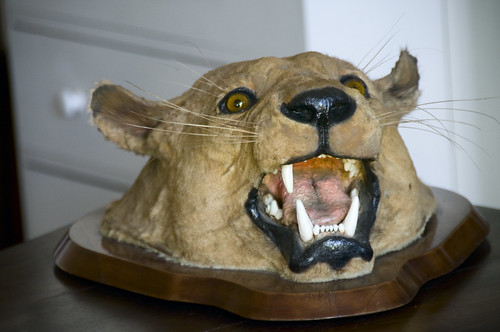
This cougar head occupies a place of honor in Papa Hemingway’s dressing area at the Hemingway Museum in the suburbs of Havana, Cuba. Photo by Harold Davis. View this image larger.
A Tale of Two Papas
Here’s a quick, trick question: Name a big, bearded public figure associated with Cuba who combined machismo with narcissism, had a fascination with firearms and was in love with his own copious verbiage.
Both Fidel Castro and the Nobel prize winning writer Ernest Hemingway fit this bill, and both liked to be called “Papa.” Mostly, Ernest’s Cuban neighbors didn’t oblige.
When Cubans refer to Fidel, they do tend to call him “Papa”—even when in their hearts they’d rather call him something nasty. But Fidel’s choice of moniker comes with enforcement: the State Security division of the Ministry of the Interior as well as the local members of the Committees in the Defense of the Revolution (CDRs).
The CDRs are civilian neighborhood watch groups whose job is to spy on everyone to make sure they are sufficiently “revolutionary”—a term that in an Orwellian twist of language has come to mean support of a government that has been in power for fifty years. There’s a CDR group for every block in every Cuban village and city, and it’s probably a good idea to often repeat “Papa” in loving tones referring to the Supreme Leader if you hang out with your local CDR representatives.
The two Papas shared a love of the ocean, fishing, and boats. They met in 1960 when Papa Castro won the first prize during the 10th Annual Ernest Hemingway Billfish Tournament by hooking a huge marlin.
Both men are associated with well-known boats. The leaky Granma brought Castro, Guevara and their revolutionary gang to Cuba; restored, the Granma sits behind glass in the place of honor in the Revolutionary Museum in Havana.
Hemingway modeled the smuggler’s boat in To Have and Have Not after his beloved sport fishing vessel, the Pilar. He used the Pilar—with beefed up armaments supplied by the Unites States war department—to help spot German submarines near Cuba during the Second World War.
Today, a restored Pilar rests on dry earth in a pavilion that’s part of the Hemingway Museum at Finca Vigia (Lookout Farm). A walkway surrounds the boat which is patrolled by guards. The Pilar is adjacent to the swimming pool in which Ava Gardner once swam naked (the pool is now empty and in bad repair), and a few hundred feet away from Hemingway’s Finca Vigia house itself.
The Mystery of the Missing Chrysler
As one guide book puts it, “the Cuban government does a good job of keeping the fantasy world of tourism and get-away vacations apart from the realities of daily life for the average Cuban person.” Millions of tourists from Canada and Europe visit Cuba every winter for a week or two of booze and sun. For the most part, these visitors are isolated in Club Med-like compounds, and have no sense of the poverty or repression faced by the average Cuban.
The brochures left in hotel rooms provide some hints of the attitude of the authorities. For example, in case of a hurricane:
Before: The hotel management will keep you informed. To slide the curtains to protect yourself in case of window glass breakage.
During: Calm down. The hotel staff is highly qualified to handle the situation. Do not hesitate to follow any instructions.
After: Keep on following official instructions. Report immediately possible damage or wounds.
The ubiquitous Customs Regulations pamphlet, found in each hotel I stayed in, somewhat oddly notes that you can’t bring microwaves, irons, or bread toasters into Cuba; however, a tourist is allowed “a camera with twelve plates or five films” and a set of “sport fishing tackle.”
The favorable nod to sport fishing gear is probably a holdover from Fidel’s enthusiasm about winning Hemingway’s sport fishing contest.
But I digress.
Outside of pseudo-Club-Med-beach-vacation spots and sex tourism, unless you are someone like me with an interest in the history of revolutionary movements and socialism, old cars and Hemingway are pretty much the only tourist games in town.
The old cars in Cuba are the genuine article—original, patched innumerable times and running on a wing and repair. No rebuilt facsimiles with retrofitted new parts, as you find in antique car shows in the United States.
I photographed this old Studebaker on the back streets of Cojimar, the fishing town where Hemingway docked the Pilar. Photo by Harold Davis. View this image larger.
Hemmingway’s car was a sleek black 1955 Chrysler New Yorker with tailfins from here to La Habana. When he left Cuba under circumstances that are still murky, Papa Hemmingway gave the Pilar to its Cuban captain—who couldn’t afford its upkeep, so the Cuban government took it over. The Chrysler New Yorker went to Hemmingway’s driver, later a Cuban policeman, who hid the car rather than give it up to the Cuban government, and then defected. He disappeared while trying to raft across the Straits of Florida. A subject of considerable speculation, the whereabouts of the Chrysler is still a mystery.
Cars can be privately owned in Cuba, and mean great comparative wealth. American cars from the 1950s have been passed down from parents to their children and then to the children’s children.
But I digress yet again.
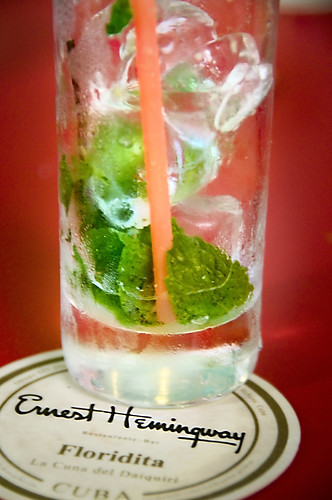
Many packaged tours of Havana feature a stop at El Floridita, famous because Hemingway drank there. Photo by Harold Davis. View this image larger.
You can drink an overpriced mojita at El Floridita, a smoke-filled bar that Hemmingway frequented—now a tourist trap that claims to be the birthplace of the daiquiri. For a CUC or two, you can view Hemmingway’s room 511 at the Hotel Ambos Mundas in La Habana. But the highlight of the Hemmingway tourist franchise is surely the Hemmingway Museum at the restored Finca Vigia, located in a suburb south of Havana.
Dead Eyes Watching
After dining at Finca Vigia a number of guests became vegetarians. Photo by Harold Davis. View this image larger.
Hemingway purchased Finca Vigia with the first infusion of royalties from For Whom the Bell Tolls—which happens to be a book that Castro took with him to the Sierra Maestra to learn about guerilla fighting tactics.
When Hemingway bought Finca Vigia, it was a modest estate in the pleasant Havana suburb of San Francisco de Paula. Here’s how Irish writer Adrian McKinty described the San Francisco de Paula of today in a 2008 article: “Now San Francisco de Paula is a typical Havana suburban slum. Backed up sewers flow in the streets, the sidewalks are crumbling, pigs root in the gutters and children are to be seen combing trash heaps for anything remotely sellable.”
Allowed to go to wrack and ruin until fairly recently, the Cuban government sponsored a massive and expensive restoration of Finca Vigia a few years back.
A typical visit to the Hemingway Museum involves paying money to get in the grounds and for the somewhat dubious privilege of peering in through open windows at the rooms Hemingway and his fourth wife, Mary Walsh, lived in. Theoretically, you can’t go inside the house. Since everything in Cuba is for sale, I gather that if you visit solo rather than in a group (as I was), you can bribe individual guards for the privilege of getting inside.
Even if you are part of a group tour, guards ask for money for privileges like a photo of Papa’s typewriter (you hand over your camera and the guard takes the photo).
In his article, Adrian McKinty describes visiting Finca Vigia after the group tours had left. He paid twenty dollars to get inside the house, and additional money for further privileges such as sitting in Hemingway’s chair and using Hemingway’s toilet.
He turned down an offer from a secret policeman to buy any book in Hemingway’s library—which includes many rare and inscribed first editions—for $200. Returning to the Hotel Sevilla in Havana, he wrote in his journal, “I pissed in Hemingway’s loo and I don’t feel good about it at all.”
Had he bought a first edition out of Hemingway’s library, I think it would have been “found” at Cuban customs in a charade accompanied by extortion.
Yup. Once again I digress.
The weird thing about Finca Vigia is all the dead animals that Papa Hemingway surrounded himself with. There are books and dead animals. The dead animals really don’t belong there. They aren’t Cuban; they are cheetah heads from Africa, bull heads from Spain, and pickled animal specimens from God knows where.
A pickled bat and iguana decorate the shelves of Hemingway’s bathroom. Photo by Harold Davis. View this image larger.
I couldn’t image living with this spectacle of death—let alone trying to write—with the dead eyes of bobcats, bulls, deer, and other species too numerous to enumerate watching me with their dead eyes.
I guess that Papa Hemingway shot many of these animals himself—but he’s a wuss compared to the primary Papa of the Cubans. Hemingway may have shot many of these animals, but Castro drove a tank at the Bay of Pigs—and, yes, the tank is there along with the Granma at the Revolutionary Museum.
Note: It’s easy for me to write the truth as I see it about Cuba. In contrast, it is very hard for someone living in Cuba to write honestly about the repressive Cuban regime. That’s why Yoani Sanchez, who writes the Generation Y blog while living in Cuba, has become a hero of mine.
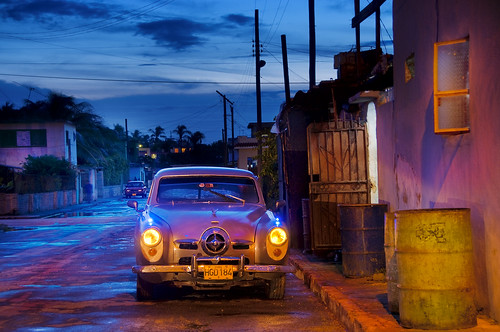
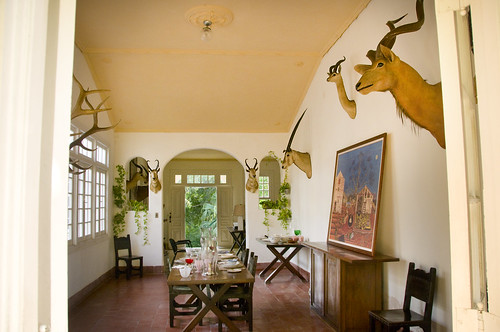
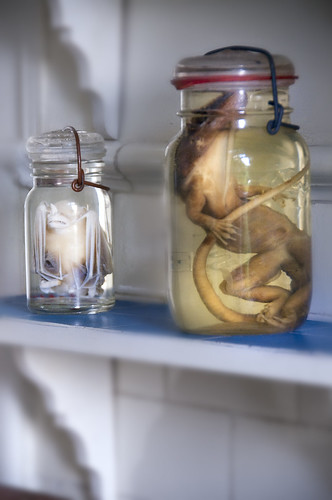
Pingback: Hemingway’s Cuba in Photos « Ernest Hemingway
Harold Davis
13 Dec 2009Proving I can’t always spell and bloggers need copy editing too: http://www.cubamania.com/cuba/showthread.php?t=26153
Osselin
26 Dec 2009About first photo.
“To be an artist consists in poeticize the reality in our mind making abstractions true-to-life ”
Josep Fàbrega (Osselin)
You did it.
Pingback: Havana Cross | Photoblog 2.0